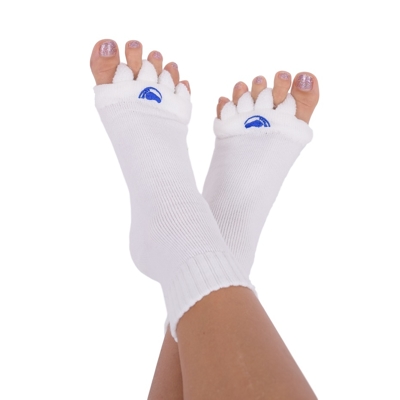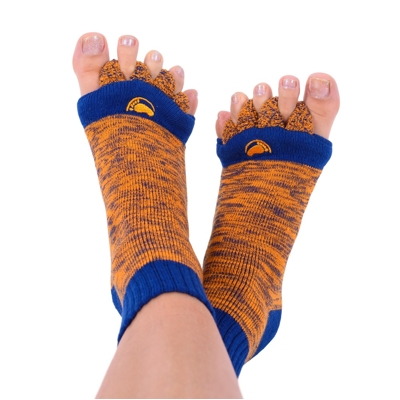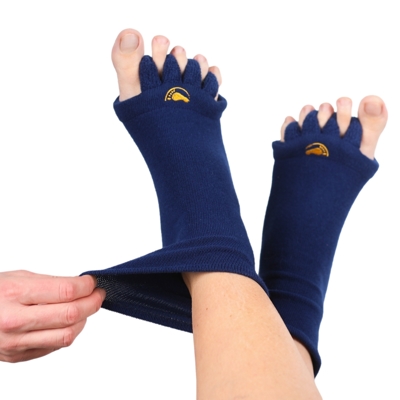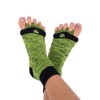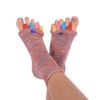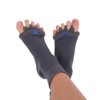Watch out for swollen feet when you're on a plane. Don't forget to pack some Foot Alignment Socks for your holiday
 Long flights to get to your holiday destination can be boring if you don't have anything to keep you entertained, but they can also be hard on your body. Especially your feet. There's a good reason why they say to wear comfortable footwear on a plane, and perhaps even take your shoes off. Our feet tend to swell during a flight. Read our tips on how to combat swollen feet and why you shouldn't forget to pack Foot Alignment Socks when you go on holiday.
Long flights to get to your holiday destination can be boring if you don't have anything to keep you entertained, but they can also be hard on your body. Especially your feet. There's a good reason why they say to wear comfortable footwear on a plane, and perhaps even take your shoes off. Our feet tend to swell during a flight. Read our tips on how to combat swollen feet and why you shouldn't forget to pack Foot Alignment Socks when you go on holiday.
Why feet swell up on a plane
If you’re on a long-haul flight, your leg muscles are less active due to all that time spent sitting down. People with sedentary jobs can have the same problem. Sitting down for prolonged periods of time slows down the circulation and causes fluid to build up in the legs, making them swell up. In addition, the dry air on the plane can leave you dehydrated, making your swelling problems worse. Add to this insufficient fluid intake or even an alcoholic drink or two during the flight and you become even more dehydrated, which also causes your body to retain more water.
Some people are more prone to swollen feet on a plane than others. Those worse off are especially:
- diabetics
- pregnant women
- smokers
- the elderly
- overweight people
When your feet swell, they get bigger around the toes, instep and ankle. Your shoes start to feel tight and you may develop blisters from the cuff of your socks. Swollen feet may be accompanied by increased sensitivity, pain, the sensation of heavy legs or even tingling.
How to prevent swelling during a flight
We’ve mentioned the crucial importance of staying hydrated, or the adverse effects of dehydration. Therefore, make sure to drink plenty of fluids before you take off and during the flight. Hydration is crucial for proper blood circulation and preventing fluid retention. With this in mind, you should limit your salt intake, especially if you tend to add more salt to your meals or prefer savoury foods.
Choose comfortable shoes that give your feet plenty of room, or take them off during the flight. You don't have to go for barefoot shoes; it’s enough to choose footwear that doesn’t cramp your toes and that lets your feet "breathe" properly. The same goes for socks. Socks that are too tight can also cause your feet to swell during the flight.
Our tips are to change position occasionally during the flight. Go to the toilet, take a walk along the aisle or stretch your legs. Or, change the position of your legs during the flight. This will aid blood flow.

Foot Alignment Socks for comfortable travel
Don't forget to pack your Foot Alignment Socks for the journey. You can of course wear them during the flight, but they also provide instant relief in the first few hours after you land or following a hard day of travelling.
As you know, the toe separators on Foot Alignment Socks relieve tension in the feet, improve circulation and reduce the risk of swelling. They help keep the feet and toes mobile, supple and less painful. If you suffer from heavy feet, swelling or deformities, Foot Alignment Socks can be an ideal addition to your care routine, and not only when you're travelling.
TIP: For swollen feet, extra-stretch loose-fit Foot Alignment Socks are ideal.

More tips for swollen feet after you land
After you land, massage your feet with a lukewarm shower, which can be alternated with warm water. Walk barefoot on the beach; pebbles will massage your feet beautifully. But you can do it on a sandy beach, too. Swimming, in the sea or in the pool, can also help your feet to recover. Of course, don't forget to drink plenty of fluids.
The swelling is usually temporary, but if it persists or is markedly worse on one foot than the other, it may signal a more serious problem, such as venous thrombosis. If the swelling does not even go down a few hours after landing, if one leg is more swollen than the other, if the swelling is more painful or if your skin is red and hot around the swelling, you should seek medical attention.
Other articles we’ve written about swollen feet:


